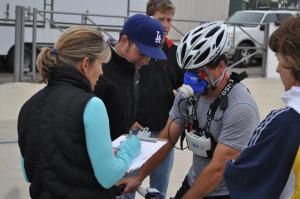ElliptiGO Inc., creators of the world’s first outdoor elliptical bike, today released the results of a metabolic testing study conducted by the Exercise and Physical Activity Resource Center (EPARC) at the University of California, San Diego (UCSD.) EPARC determined that the energy cost of riding an ElliptiGO required, on average, 33% more effort than cycling at that same speed. They also found that heart rate responses and perceived effort levels were very similar between the ElliptiGO and running, with riding an ElliptiGO at 16mph equivalent to running at 7.5mph (8:00 min/mile) and riding at 18.5mph equivalent to running at 8.6mph (7:00 min/mile.)
“From the very start, we designed the ElliptiGO elliptical bicycle specifically to emulate the running motion,” stated Brent Teal, Co-Founder and Co-President of ElliptiGO. “Our goal is to provide a high-performance workout experience that closely simulates running outdoors, while eliminating the associated impact. With the results of this study, we now have the data to show that our design was successful.”
Combining the best of running, cycling and the elliptical trainer, the ElliptiGO bike allows athletes of all levels to get a high-intensity workout without experiencing the repetitive impact of running. Healthy and injured athletes alike have found it the most effective way to get an outdoor running experience without the usual pounding on their bodies.
For the study, 6 male and female subjects between 30-41 years old completed multiple laps around the flat inner skirt of the San Diego Velodrome while wearing a heart monitor and a Cosmed k4b face mask with a portable metabolic unit. They rode a traditional bike, an ElliptiGO elliptical bicycle, and ran, at intensities ranging from easy to very difficult to capture data across all three exercise modes.
There are many factors that affect the energy expenditure of a given ElliptiGO bike rider or cyclist including rider size, weight, riding experience, and overall fitness. During flat riding conditions at speeds above 10mph, as was investigated in this study, the most significant factor is a rider’s size and the corresponding frontal area that they have to push through the air like a sail. The upright riding position of the ElliptiGO bicycle gives the rider a much greater frontal area when compared to the more aerodynamic, hunched-over position of cycling, thus resulting in a higher effort required for the same speed. The study found that riding an ElliptiGO elliptical bicycle required, on average, 33% more effort than cycling at that same speed.
The study also found that heart rate responses and perceived exertion levels were very similar between the ElliptiGO bicycle and running. It was determined that riding an ElliptiGO bike at 16 mph was equivalent to running at 7.5 mph (8 min/mile), and riding at 18.5 mph was equivalent to running at 8.6 mph (7 min/mile).
“The results of this study will allow us to create a model for comparing the caloric burn rate of riding an ElliptiGO elliptical bicycle with cycling and running, so that people can get a more accurate estimation based on their individual height and weight,” said Teal. “That way both professional athletes and everyday fitness enthusiasts will be able to incorporate the ElliptiGO bicycle into their training with more specificity.”
Download more information PDF.



One Response
[…] 4. It’s hard but effective. In studies it’s been shown that ElliptiGO training requires 33% more effort than cycling, making it on par with a running workout. 5. But it’s still FUN! Although it requires more effort […]